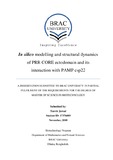| dc.contributor.advisor | Mubassir, M H M | |
| dc.contributor.author | Jawad, Tanvir | |
| dc.date.accessioned | 2019-03-12T05:57:29Z | |
| dc.date.available | 2019-03-12T05:57:29Z | |
| dc.date.copyright | 2018 | |
| dc.date.issued | 2018-11 | |
| dc.identifier.other | ID 17376003 | |
| dc.identifier.uri | http://hdl.handle.net/10361/11545 | |
| dc.description | This thesis report is submitted in partial fulfilment of the requirement for the degree of Master of Science in Biotechnology, 2018. | en_US |
| dc.description | Catalogued from PDF version of thesis report. | |
| dc.description | Includes bibliographical references (pages 61-65). | |
| dc.description.abstract | Plants being sessile organisms are continuously being subjected to pathogens prevailing in their environment. Understanding the theory behind it would be a great step towards understanding the mechanisms making plants disease resistant. There are two ways in which plant defences are activated- first by structural interaction between the pathogen-associated molecular pattern (PAMP) and the pattern-recognition receptor (PRR) known as pattern-triggered immunity (PTI) and secondly through effectors known as effector triggered immunity (ETI). In PTI, to combat the pathogens, plants employ PRRs which detect PAMPs and employs co-receptor proteins. The aim of this study is to acquire a better understanding of the early stages of PTI mediated by PRR CORE and PAMP csp22 by modelling of these followed by docking and molecular dynamics (MD) simulation using GROMACS software suite. The leucine rich repeat (LRR) on the PRR is responsible for binding to the PAMP, so different in silico modelling approaches were used to acquire the CORE LRR 3D structure. Of which only the model generated by I-TASSER using the threading method gave the best results with verification tools such as ERRAT, Verify 3D and Ramachandran plot. The docking result also shows the PAMP csp22 binds at one lateral side of the CORE LRR with the co-receptor BAK1 attaching head on, on to the same lateral side, which is very consistent with the protein interaction observed in the reference FLS2 crystalline complex. The interactions between the three proteins were also analyzed using the protein interaction calculator (PIC) and it was seen that after the MD simulation the number of hydrogen bonds formed between them almost became half. Starting with 42 H-bonds before the simulation, whereas only 22 afterwards. These changes are significant indicators of conformational changes that take place over the simulation period and are vital in understanding the early events of PTI by the receptor protein CORE. | en_US |
| dc.description.statementofresponsibility | Tanvir Jawad | |
| dc.format.extent | 68 pages | |
| dc.language.iso | en | en_US |
| dc.publisher | BRAC University | en_US |
| dc.rights | BRAC University theses are protected by copyright. They may be viewed from this source for any purpose, but reproduction or distribution in any format is prohibited without written permission. | |
| dc.subject | In silico modelling | en_US |
| dc.subject | PAMP csp22 | en_US |
| dc.subject | Pattern-recognition receptor | en_US |
| dc.subject | Pattern-triggered immunity | en_US |
| dc.subject | CORE LRR 3D | en_US |
| dc.subject.lcsh | Agriculture | |
| dc.subject.lcsh | Systems biology | |
| dc.title | In silico modelling and structural dynamics of PRR CORE ectodomain and its interaction with PAMP csp22 | en_US |
| dc.type | Thesis | en_US |
| dc.contributor.department | Department of Mathematics and Natural Sciences, BRAC University | |
| dc.description.degree | M. Biotechnology | |

